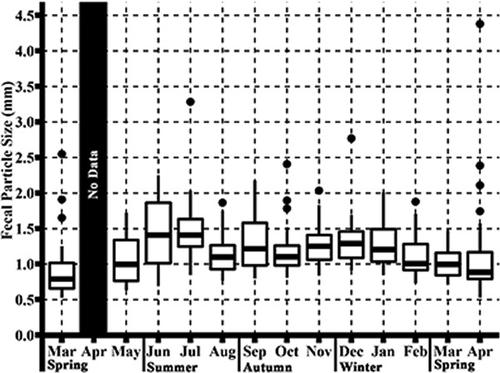当前位置:
X-MOL 学术
›
Am. J. Primatol.
›
论文详情
Our official English website, www.x-mol.net, welcomes your
feedback! (Note: you will need to create a separate account there.)
Effects of diet and age–sex class on the fecal particle size of wild Japanese macaques (Macaca fuscata yakui)
American Journal of Primatology ( IF 2.0 ) Pub Date : 2021-02-27 , DOI: 10.1002/ajp.23245 Tianmeng He 1 , Wanyi Lee 1 , Goro Hanya 1
American Journal of Primatology ( IF 2.0 ) Pub Date : 2021-02-27 , DOI: 10.1002/ajp.23245 Tianmeng He 1 , Wanyi Lee 1 , Goro Hanya 1
Affiliation

|
Fecal particle size provides important information on the feeding and digestion of herbivores. Understanding the effects of the potential proximate determinants on fecal particle size helps us interpret this widely used measurement. In folivores, previous studies found that diet composition, dietary toughness, and age–sex‐related factors, such as body size and tooth wear, influenced fecal particle size. However, the role of these factors remains unknown in frugivorous and omnivorous primates. This study aims to clarify how age–sex class and diet influence fecal particle size in omnivorous Japanese macaques in Yakushima. We expected that their variable diet and differences among age–sex classes would cause variations in fecal particle size. We simultaneously documented Japanese macaques' diet, dietary toughness, and fecal particle size in the lowland area of Yakushima in the period from March 2018 to April 2019. Unexpectedly, fecal particle size showed limited differences across months and no difference among age–sex classes. Dietary toughness showed no effects on fecal particle size, while the consumption of fruits showed only a marginally significant negative effect. Our data indicate that the results of chewing were not affected by dietary toughness in our study subjects, while age–sex classes showed no difference in food comminution. This lack of variation might derive from a diet with low dietary toughness. We also found that the physical structure of preferred foods played an important role in fecal particle size variations. These results suggest that food comminution is less variable in frugivorous and omnivorous primates compared to highly specialized species (e.g., geladas). Factors other than what we examined in this study, such as food physical structure and chewing behavior, should also be taken into consideration.
中文翻译:

饮食和年龄-性别等级对野生日本猕猴(Macaca fuscata yakui)粪便粒径的影响
粪便颗粒大小提供了有关食草动物进食和消化的重要信息。了解潜在的近似决定因素对粪便粒径的影响有助于我们解释这一广泛使用的测量方法。在食叶动物中,之前的研究发现,饮食成分、饮食韧性和年龄性别相关因素,如体型和牙齿磨损,都会影响粪便颗粒大小。然而,这些因素在食果和杂食灵长类动物中的作用仍然未知。本研究旨在阐明年龄-性别等级和饮食如何影响屋久岛杂食性日本猕猴的粪便颗粒大小。我们预计他们的饮食和年龄-性别之间的差异会导致粪便颗粒大小的变化。我们同时记录了日本猕猴的饮食、饮食韧性、2018 年 3 月至 2019 年 4 月期间屋久岛低地地区的粪便粒径和粪便粒径。出乎意料的是,粪便粒径在几个月内表现出有限的差异,并且在年龄-性别等级之间没有差异。饮食韧性对粪便颗粒大小没有影响,而水果的消耗仅显示出轻微的负面影响。我们的数据表明,咀嚼的结果不受我们研究对象饮食韧性的影响,而年龄-性别等级在食物粉碎方面没有差异。这种缺乏变化可能源于饮食韧性低的饮食。我们还发现,偏好食物的物理结构在粪便粒径变化中起着重要作用。这些结果表明,与高度特化的物种(例如,geladas)相比,食果和杂食灵长类动物的食物粉碎变化较小。除了我们在本研究中检查的因素外,还应考虑食物物理结构和咀嚼行为等因素。
更新日期:2021-04-29
中文翻译:

饮食和年龄-性别等级对野生日本猕猴(Macaca fuscata yakui)粪便粒径的影响
粪便颗粒大小提供了有关食草动物进食和消化的重要信息。了解潜在的近似决定因素对粪便粒径的影响有助于我们解释这一广泛使用的测量方法。在食叶动物中,之前的研究发现,饮食成分、饮食韧性和年龄性别相关因素,如体型和牙齿磨损,都会影响粪便颗粒大小。然而,这些因素在食果和杂食灵长类动物中的作用仍然未知。本研究旨在阐明年龄-性别等级和饮食如何影响屋久岛杂食性日本猕猴的粪便颗粒大小。我们预计他们的饮食和年龄-性别之间的差异会导致粪便颗粒大小的变化。我们同时记录了日本猕猴的饮食、饮食韧性、2018 年 3 月至 2019 年 4 月期间屋久岛低地地区的粪便粒径和粪便粒径。出乎意料的是,粪便粒径在几个月内表现出有限的差异,并且在年龄-性别等级之间没有差异。饮食韧性对粪便颗粒大小没有影响,而水果的消耗仅显示出轻微的负面影响。我们的数据表明,咀嚼的结果不受我们研究对象饮食韧性的影响,而年龄-性别等级在食物粉碎方面没有差异。这种缺乏变化可能源于饮食韧性低的饮食。我们还发现,偏好食物的物理结构在粪便粒径变化中起着重要作用。这些结果表明,与高度特化的物种(例如,geladas)相比,食果和杂食灵长类动物的食物粉碎变化较小。除了我们在本研究中检查的因素外,还应考虑食物物理结构和咀嚼行为等因素。











































 京公网安备 11010802027423号
京公网安备 11010802027423号